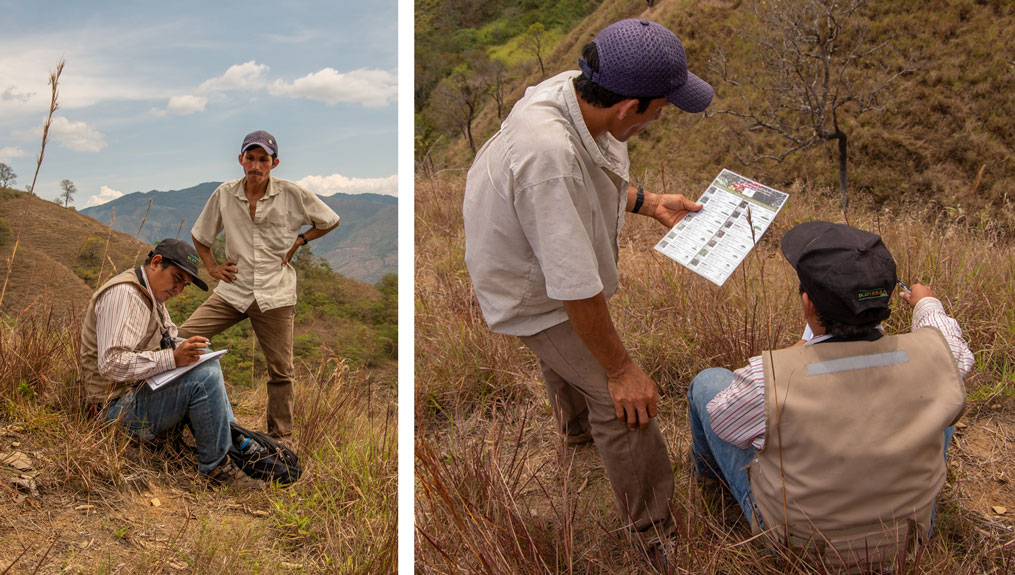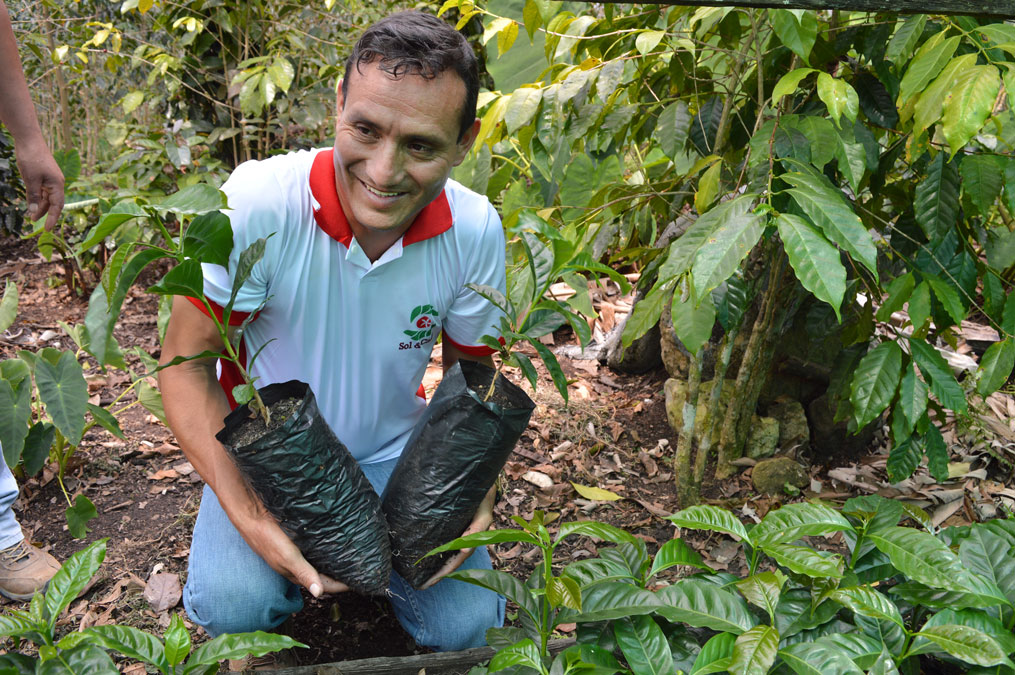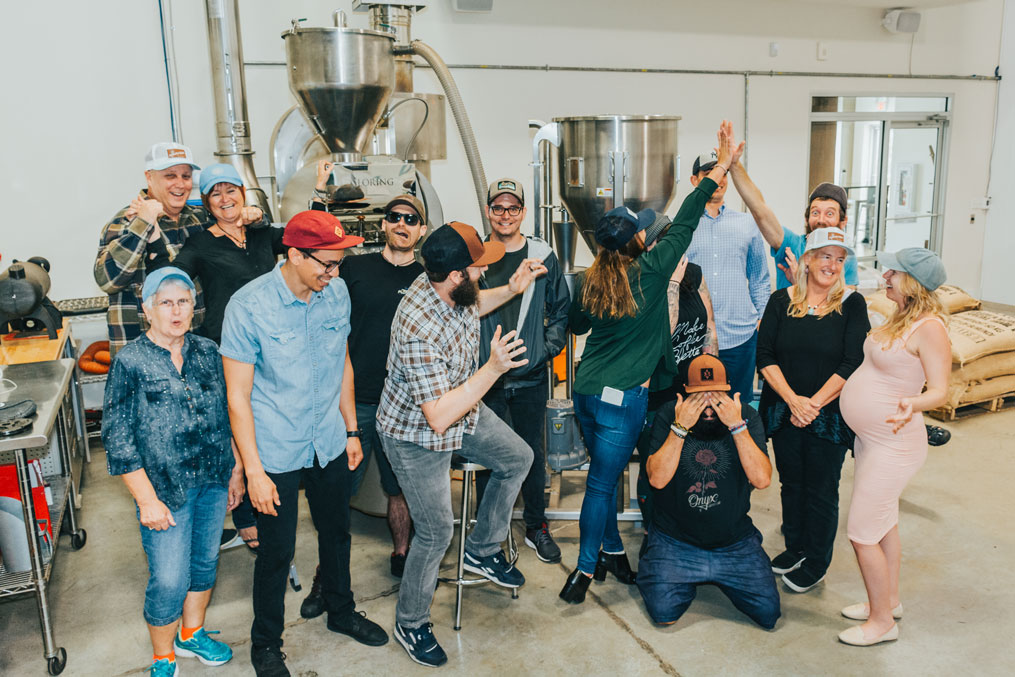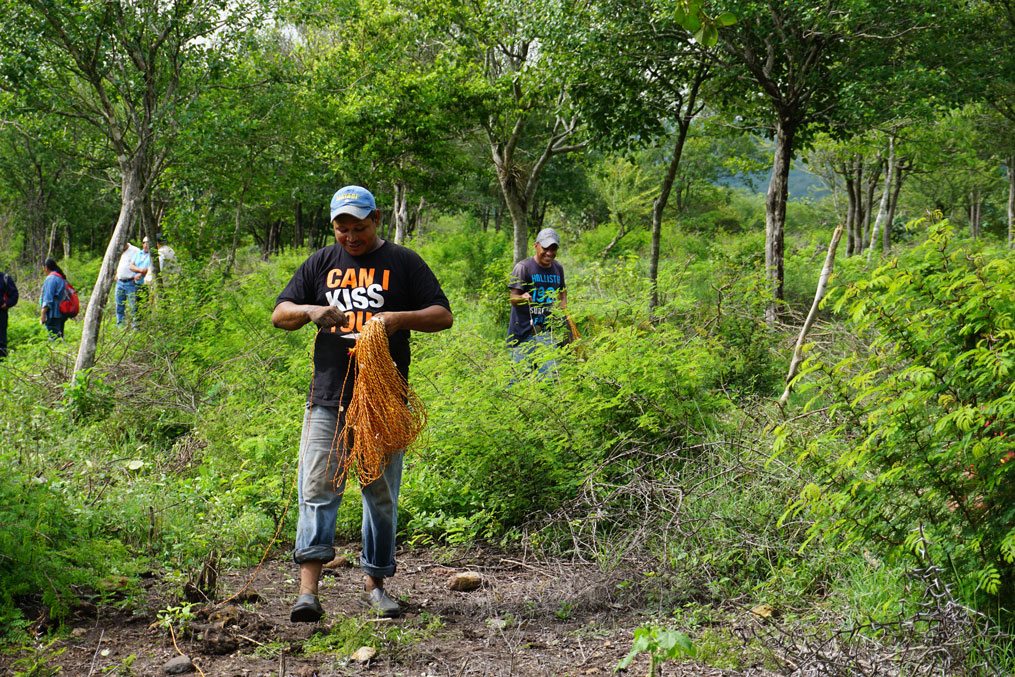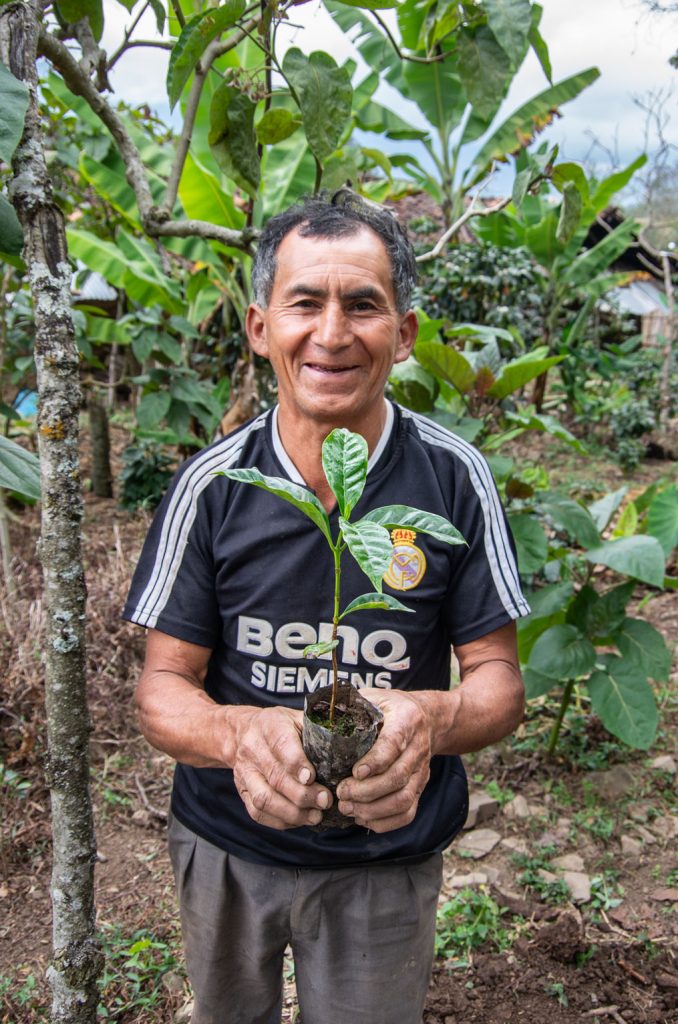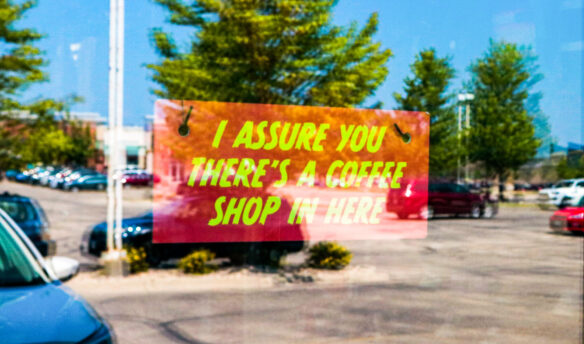Farmer Justina Gutierrez Munos planting saplings to reforest her land in Nicaragua as part of Taking Root’s carbon project.
“There is no such thing as one sustainable business,” entrepreneur Judy Wicks stated in her October 2014 lecture, “Building a New Economy: What’s Love Got to Do With It?”
“No matter how many great practices we have in our company—recycling, paying a living wage, solar hot water—we can only be part of a sustainable system,” she goes on, “and we have to share and cooperate in order to build that sustainable system.”
Although no one actor can address all sustainability concerns, individual coffee roasting and café companies are starting to take more responsibility for the carbon footprint of their operations and supply chains. Together, they construct a larger sustainable system that reduces new emissions and sequesters existing carbon.
“When roasting [and other coffee] businesses want to reduce their impact on climate change,” says Guillaume Nadeau, Deputy Director-General of ECOTIERRA, an agroforestry project developer based in Sherbrooke, Canada, “there are a few steps to follow: identify emissions sources, quantify emissions, reduce emissions where possible, and offset emissions with the voluntary purchase of carbon credits.”
This article will break down each of the steps Nadeau identifies and how coffee businesses worldwide are implementing tools to measure their impact and fight climate change.
Identify Sources & Quantify Emissions
Amavida Coffee consists of a wholesale roastery and four café locations in Santa Rosa Beach, Florida. They’re one of the 24 members of the importing collective Cooperative Coffees and have been a certified B Corporation since 2014.
“Our journey with carbon goes back to when we started with the B Corp,” says founder Dan Bailey. “I remember reading [a question], ‘Do you measure carbon?’ Fast-forward many years, and we made incremental improvements to our company in the various tenets B Corp advocates of being a responsible business.”
Further inspired by Cooperative Coffees’ initiative to measure the impact of carbon from grower to roaster, two years ago, Amavida set out to answer the question, “What would it take to become a carbon-neutral company?”
The exercise of calculating emissions—from employee commutes to electricity usage—obligates businesses to take a close look at their operations. Like all accounting, this process defines which activities are most costly in terms of carbon and requires parameters to strike a balance.
“You have a choice with what you will measure,” explains Will Sheldon, Commercial Director for Vancouver-based not-for-profit Taking Root. “It’s called scoping: asking, ‘What am I going to take responsibility for?'”
According to the standards outlined by the Greenhouse Gas Protocol:
- “Scope 1 emissions are direct emissions from owned or controlled sources.
- Scope 2 emissions are indirect emissions from the generation of purchased energy.
- Scope 3 emissions are all indirect emissions (not included in scope 2) that occur in the value chain of the reporting company, including both upstream and downstream emissions.”
In New York, Driftaway Coffee used a free calculator from the nonprofit Carbonfund.org as a tool to calculate their emissions.
“Initially, we thought we would hire an outside agency or consultant, but we wanted to dive in ourselves and learn what our largest areas of emissions were and how to mitigate them ourselves. We spent time mapping out the workflow to calculate our carbon footprint,” says Suyog Mody, one of Driftaway’s cofounders. “We have a unique business model when it comes to coffee, with 100% e-commerce operations, so we have quite a customized calculator.”
Jeremy Manion, Carbon Development Manager for Corporate Partnerships at Arbor Day Foundation, a reforestation-focused nonprofit based in Lincoln, Nebraska, recommends the CoolClimate Network calculators developed by the University of California, Berkeley.
“We use those to help individuals and small to medium businesses get a general sense of where they are from a footprint standpoint,” he says. Larger corporations, especially publicly traded companies, undergo formal carbon accounting to make verified claims to their shareholders. “Assessing emissions, especially in land-use sectors—agriculture to beverage companies—is rapidly evolving. Historically, most companies haven’t tracked emissions from land-use change.”
Deforestation is a significant source of drastic changes to the natural landscape, which, he adds, “applies directly to coffee and the rest of the agricultural sector.” For roasters and retailers, emissions from coffee production land use belong to Scope 3. Carbon responsibility starts at Scope 1, with what a business can directly control.
“Most people think it’s complicated,” says Bailey. “What we discovered is that we have to simplify it. If we’re not careful, perfection will be the enemy of progress here.” The measurement stage can become complex, but companies can also use free calculators and industry averages to arrive at initial numbers.
“Offsetting should be done like your tax return, ” suggests Nadeau, meaning it should be done annually and as a regular part of your business.
The measurement stage is most important because it identifies key areas to target in the next step: reduction.
Reduce Emissions Where Possible
Jennifer Pawlik, the Program Manager and Benefits Officer at Amavida, says, “Each of us has done something this week that made a reduction. We were just making decisions about packaging. Can we buy it down the road versus having it shipped in?”
“[At Driftaway], we’ve made a conscious decision to partner with reputable importers instead of visiting every coffee farm we source from and maintaining communication online as much as possible,” says Mody. “We roast 75% of our coffee on an incredibly efficient Loring Kestrel S35. This keeps our Scope 1 emissions from roasting to an absolute minimum.”
For companies that want to tackle their Scope 3 emissions, Nadeau highly recommends sourcing organic coffee. “In monoculture and conventional agriculture,” he says, “there is a loss in soil quality and carbon in the soil” that is released. Non-organic farming has additional emissions from fertilizers and agrochemicals that are eliminated when sourcing organic.
Sheldon at Taking Root stresses the importance of digging into reductions before considering offsets. “If you look at recent IPCC [Intergovernmental Panel on Climate Change] reports, not only do we need to get every organization in the world to zero emissions, but we also need to remove carbon from the air,” he says. “It is far better to not emit in the first place than to emit and then offset.”
Offset Remaining Emissions
Offsets, also called carbon credits, represent one metric tonne of carbon that has either been removed from the atmosphere through sequestration or prevented from entering the atmosphere through avoidance. Sequestration often takes the form of reforestation and afforestation (planting new forests), while conservation prevents emissions from deforestation and degradation.
Arbor Day’s Manion mentioned that agriculture is a primary global driver of land degradation and deforestation emissions. This also makes agriculture an industry well positioned to change its land-use patterns to reduce emissions and ultimately capture carbon—which is precisely what project developers like ECOTIERRA aim to do by integrating agroforestry with the production of carbon offsets.
“A good carbon offset for us,” says Nadeau, “is an offset certified by a recognized certification standard like the Verified Carbon Standard; an ex-post offset from past carbon capture of emission reduction versus an ex-ante carbon offset from future carbon capture or emission reduction, and from a project with positive social and environmental impacts.”
Nadeau likens the difference between ex-post and ex-ante credits as comparable to buying produce at a farmers market versus purchasing a share of a CSA to receive produce later. Carbon credits of both kinds can be traded (bought and sold) on the voluntary carbon market.
Once they are sold to an “end-user” as an offset, they are “retired” from the market, and retirement is documented in a public registry to prevent double counting. The certification process for carbon credit production is like that for coffee production, with a nonprofit organization setting the standard and approved, accredited auditing companies checking against the standards. Projects must both be validated in plan and verified in execution.
Marisa de Belloy, CEO of the nonprofit Cool Effect in Greenbrae, California, explains that “when purchasing an offset, it’s important to look for transparency in pricing details including due diligence documents to accurately track where your money is going.” De Belloy cites the Gold Standard, Verified Carbon Standard, Climate Action Reserve, and American Carbon Registry as some of the world’s major carbon standards.
Beyond the act of purchasing an offset, Taking Root realized that “we had carbon offset buyers who were saying to us, ‘We’ve got this thing called a carbon credit, but it’s invisible. How do we know the impact?'” says Sheldon. “So we created a tool called FarmTrace.”
Properties are mapped in the field as polygons on a mobile app connected to satellite imagery and other databases. “We run machine learning algorithms so that we can automatically interpret and report against the carbon stored and forest cover on the farm,” he says. “We can track impact on an ongoing basis.”
Staying Close to the Value Chain
Coffee companies looking to offset their carbon footprint remaining after reductions can choose projects close to the coffee value chain.
“There are some cheap carbon offsets,” says Bailey at Amavida. “You can find them as low as three dollars per tonne. We pay almost twenty dollars per tonne for the quality of the program. We decided to partner with Taking Root because they’re doing land management programs and resiliency projects with coffee growers.”
“We finalized our partnership in September 2019,” adds Pawlik. “As a partner, we’ve offset for the whole organization,” meaning both the roastery and the cafés.
Meanwhile, Driftaway collaborated with Cool Effect to offset its carbon footprint. “The [Peru Alto Mayo Protected Forest] project that we chose for our offsets will help with carbon absorption and releasing oxygen, but it is close to our coffee hearts since it trains over 600 families to improve coffee yields,” says Mody.
Proximity to the value chain works the other way, too. Arbor Day Foundation is a major purchaser of carbon credits generated by agroforestry projects that produce other crops, like coffee. Arbor Day has long roasted and sold Arbor Day Coffee to hospitality clients and directly to consumers.
“Sourcing from [ECOTIERRA’s Café Selva Norte project in Peru] demonstrates our commitment to the system of carbon insetting. If we’re purchasing carbon credits, we should be purchasing the coffee and leading by example in that process,” says Jon Ferguson, Arbor Day’s Coffee Specialist. On his sourcing trips, Ferguson has seen how farmers from Honduras to Peru fight to preserve their forests and protect land that is actively managed or held in preserves from deforestation.
The insetting Ferguson refers to—building carbon offsets into a value chain, such as coffee production—is moving in the direction Wicks describes, where businesses work together to create a sustainable system in its cooperation. This way, something as daunting as responsibility for carbon emissions for the entire coffee supply chain becomes the shared responsibility of every link.
This story was originally published on April 7, 2020, and has been edited to reflect Fresh Cup’s current editorial standards. [/et_pb_text][/et_pb_column] [/et_pb_row] [/et_pb_section]



